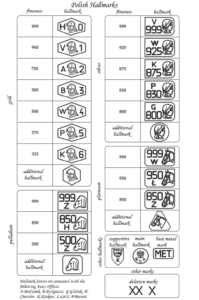Hallmarks and fineness marks
Under the Polish law, precious metals are: platinum, gold, silver and metals from the platinum group: iridium, osmium, palladium, rhodium and ruthenium, in pure state or in alloys with other metals.
In jewellery it is alloys rather than pure precious metals which are used. In their pure states, Gold and silver are not suitable for production of jewellery – they are fragile, brittle and delicate in addition to being quite expensive. Their physical and mechanical properties are improved by alloying with other metals, forming a so-called alloy. An alloy contains, apart from the base precious metal, also other metals, such as silver, copper, nickel and pallad.
The ratio of the mass of the pure precious metal to the mass of the alloy expressed in thousandths is a fineness mark. Precious metal products intended for trade in the territory of Republic of Poland subject to the requirement of assaying and hallmarking conducted by Assay Offices.
Hallmarking involves directly strucking a product, either using steel punches or laser, with a special mark known as a hallmark. Products made of platinum or gold with mass lower than 1 gram and those made of silver under 5 grams do not subject to the requirement of assaying or hallmarking.
A hallmark consists of a letter identifying the Assay Office, a symbol indicating the type of precious metal and number indicatory of the fineness of an alloy. We encourage you to read the information provided on the website of the Regional Assay Office in Warsaw.
Letters associated with particular Assay Offices
A – Białystok B – Bydgoszcz
G – Gdańsk H – Chorzów
K – Kraków Ł – Łódź
P – Poznań V – Wrocław
W – Warszawa Z – Częstochowa
All products made of precious metals offered by our store are hallmarked by the relevant Assay Office (with the exception of products made of silver under the weight of 5g) which fully ensures the authenticity of the material with which our jewellery is produced. Every product made of silver also has struck sponsor’s mark.
Where to look for hallmarks and and fineness marks?
Hallmarks are predominantly struck in places that cannot be seen easily. In case of jewellery you can look for them on the linking elements. Silver and golden chains may have small stamps on the last link, tip or a flattenned ring on the lobster clasp (or the element on which we attach the it). The lobster clasp, as an additional element, should have a separate hallmark. One-sized medallions and pendants are hallmarked on the undecorated side. Apart from that, a fineness mark of the precious metal is struck next to the hallmark or other places. The smaller a product, the more difficult to see that, which is why often a magnifying glass is required to properly examine the hallmarks and fineness marks. The size problem means that it is not possible to struck a hallmark with details identical as shown in the above chart. However, a certain silhouette of the pattern, which identifies the particular hallmark being used, should be preserved. Hallmarks and fineness marks can be found not only on the jewellery. The Polish law requires jewellery to be hallmarked, but only when their weight exceeds 5 grams if silver and 1 gram in case of gold and platinum. Lighter products do not need to be hallmarked.

